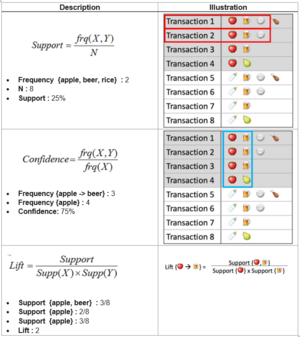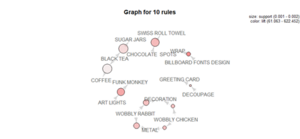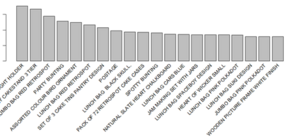Group01 proposal
Contents
Abstract
Market Basket Analysis (MBA) is one of the key techniques used by large retailers to uncover associations between products brought by consumers. In our case, we apply a sequential version of MBA, called “sequential itemset mining” or “sequential pattern mining”, to analyze whether buying one item in the past indicates a higher likelihood of buying other things in the future. For instance, whether purchasing peanut butter implies sales of bread in the near future.
Data Source
This data from the ' The Instacart Online Grocery Shopping Dataset 2017 '. [1]
About Data Set
There are overall 3421083 number of orders of 206209 customers over 49688 products in 21 major catagories.
Background of Association Rule Mining
What is Association Rule Mining?
Association Rule Mining is used when you want to find an association between different objects in a set, find frequent patterns in a transaction database, relational databases or any other information repository.
What is Association Rules?
Association Rule Mining can tell you what items do customers frequently buy together by generating a set of rules called Association Rules in form if this then that.
How do we apply Association Rule Mining?
The applications of Association Rule Mining are found in Marketing, Basket Data Analysis (or Market Basket Analysis) in retailing, clustering and classification. In our project, we apply it particularly by Market Basket Analysis.
Principal indicators of Association Rules:
Application UI
Data loaded and preprocessing
Gentric market basket analysis by selecting threshold
Rule network on categories or items of interest
Time series analysis of selected category or item (line chart or bar chart)
Show the most ranking rules over time & Display rule between two items or categories over time
Objects
1.Display the overview of relationship between category using Network diagram
2.Show product bundles that expect to be consumed simultaneously and key indicators of each
3.Interactively visualize how these bundles evolve over time
Packages Use
We hypothesize that greater economic development increases health risks. There are enough evidences to support that developing of Chinese economy brings great pressure which increases the rate of unhealthy behaviours such as smoking and alcohol abuse, and notably high occurrences of chronic diseases such as hypertension, heart disease, and diabetes. Therefore, nationals have higher health risks.
Model
Linear Probability Model (LPM) is a popular model used in social sciences research and we use it to examine our hypothesis, is there any relationship between Health Risks and Economy Developments in China. LPM is a regression model where the target or dependent variable is a binary variable and the independent variables can be binary and continuous. In our project, we use equation similar to following one to test hypothesis.
Sensitivity Test
After using LPM on our hypothesis, we need to finish robustness to test model stability. We use two ways. First is that we replace our original economy index with the other one and see is there any difference on results. Second, we use household based index rather than individual base index and see the results.
Critics of Existing Works
Our project is an extension of this research published by Bakkeli in 2016.Table below shows a summary about this work.
Bakkeli, N. (2016). Income inequality and health in China: A panel data analysis.Social Science & Medicine, 157, 39–47.
| Package | Description |
|---|---|
| arules | Provides the infrastructure for representing, manipulating and analyzing transaction data and patterns (frequent itemsets and association rules). |
| arulesViz | Extends package 'arules' with various visualization techniques for association rules and item-sets. The package also includes several interactive visualizations for rule exploration. |
| tidyverse | The tidyverse is an opinionated collection of R packages designed for data science. |
| readr | Read Excel Files in R. |
| dplyr | Tools for Splitting, Applying and Combining Data. |
| ggplot2 | Create graphics and charts. |
| Visnetwork | Create graphics and charts. |
Team Members
References
- Market Basket Analysis using R.
- A Visual Application for Better Business Decision Making.
- A Gentle Introduction on Market Basket Analysis — Association Rules
- [ https://blog.revolutionanalytics.com/2019/02/sequential-pattern-mining-in-r.html Tutorial: Sequential Pattern Mining in R for Business Recommendations]


